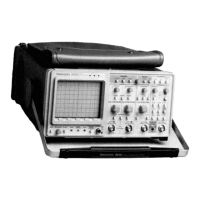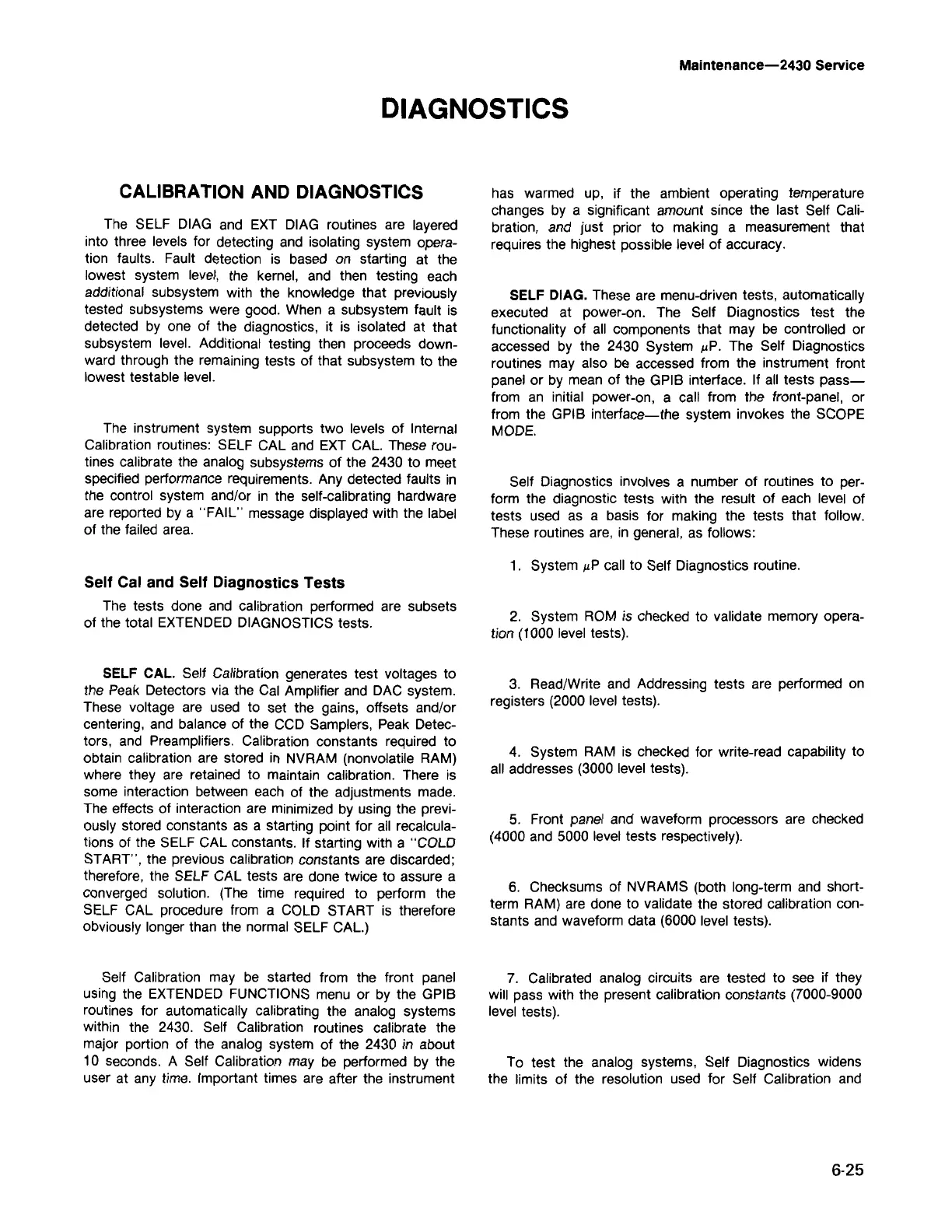6-25
To test the analog systems, Self Diagnostics widens
the limits of the resolution used for Self Calibration and
7. Calibrated analog circuits are tested to see if they
will pass with the present calibration constants (7000-9000
level tests).
6. Checksums of NVRAMS (both long-term and short-
term RAM) are done to validate the stored calibration con-
stants and waveform data (6000 level tests).
5. Front panel and waveform processors are checked
(4000 and 5000 level tests respectively).
4. System RAM is checked for write-read capability to
all addresses (3000 level tests).
3. Read/Write and Addressing tests are performed on
registers (2000 level tests).
2. System ROM is checked to validate memory opera-
tion (1000 level tests).
1. System llP call to Self Diagnostics routine.
Self Diagnostics involves a number of routines to per-
form the diagnostic tests with the result of each level of
tests used as a basis for making the tests that follow.
These routines are, in general, as follows:
SELF DIAG. These are menu-driven tests, automatically
executed at power-on. The Self Diagnostics test the
functionality of all components that may be controlled or
accessed by the 2430 System llP. The Self Diagnostics
routines may also be accessed from the instrument front
panel or by mean of the GPIB interface. If all tests pass-
from an initial power-on, a call from the front-panel, or
from the GPIB interface-the system invokes the SCOPE
MODE.
has warmed up, if the ambient operating temperature
changes by a significant amount since the last Self Cali-
bration, and just prior to making a measurement that
requires the highest possible level of accuracy.
Self Calibration may be started from the front panel
using the EXTENDED FUNCTIONS menu or by the GPIB
routines for automatically calibrating the analog systems
within the 2430. Self Calibration routines calibrate the
major portion of the analog system of the 2430 in about
10 seconds. A Self Calibration may be performed by the
user at any time. Important times are after the instrument
SELF CAL. Self Calibration generates test voltages to
the Peak Detectors via the Cal Amplifier and DAC system.
These voltage are used to set the gains, offsets and/or
centering, and balance of the CCD Samplers, Peak Detec-
tors, and Preamplifiers. Calibration constants required to
obtain calibration are stored in NVRAM (nonvolatile RAM)
where they are retained to maintain calibration. There is
some interaction between each of the adjustments made.
The effects of interaction are minimized by using the previ-
ously stored constants as a starting point for all recalcula-
tions of the SELF CAL constants. If starting with a "COLD
START", the previous calibration constants are discarded;
therefore, the SELF CAL tests are done twice to assure a
converged solution. (The time required to perform the
SELF CAL procedure from a COLD START is therefore
obviously longer than the normal SELF CAL.)
Self Cal and Self Diagnostics Tests
The tests done and calibration performed are subsets
of the total EXTENDED DIAGNOSTICS tests.
The instrument system supports two levels of Internal
Calibration routines: SELF CAL and EXT CAL. These rou-
tines calibrate the analog subsystems of the 2430 to meet
specified performance requirements. Any detected faults in
the control system and/or in the self-calibrating hardware
are reported by a "FAIL" message displayed with the label
of the failed area.
The SELF DIAG and EXT DIAG routines are layered
into three levels for detecting and isolating system opera-
tion faults. Fault detection is based on starting at the
lowest system level, the kernel, and then testing each
additional subsystem with the knowledge that previously
tested subsystems were good. When a subsystem fault is
detected by one of the diagnostics, it is isolated at that
subsystem level. Additional testing then proceeds down-
ward through the remaining tests of that subsystem to the
lowest testable level.
CALIBRATION AND DIAGNOSTICS
DIAGNOSTICS
Maintenance-2430 Service

